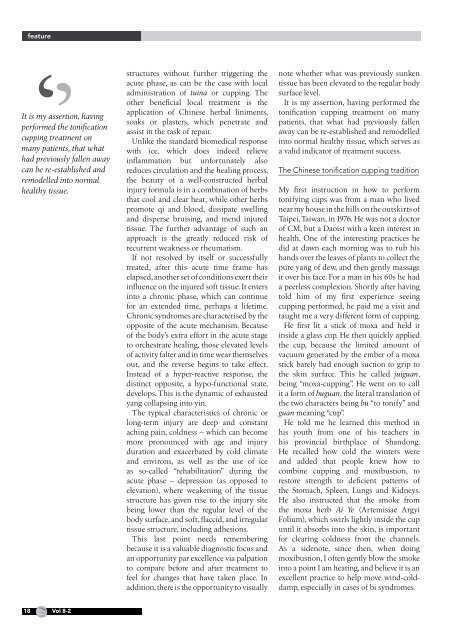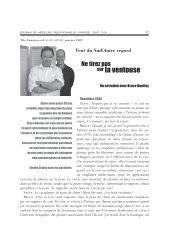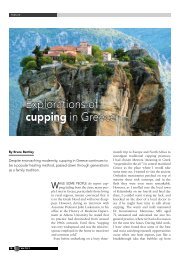Cupping Deficiency - Australian School of Traditional Thai Massage
Cupping Deficiency - Australian School of Traditional Thai Massage
Cupping Deficiency - Australian School of Traditional Thai Massage
You also want an ePaper? Increase the reach of your titles
YUMPU automatically turns print PDFs into web optimized ePapers that Google loves.
18<br />
feature<br />
‘’<br />
It is my assertion, having<br />
performed the tonification<br />
cupping treatment on<br />
many patients, that what<br />
had previously fallen away<br />
can be re-established and<br />
remodelled into normal<br />
healthy tissue.<br />
Vol 8-2<br />
structures without further triggering the<br />
acute phase, as can be the case with local<br />
administration <strong>of</strong> tuina or cupping. The<br />
other beneficial local treatment is the<br />
application <strong>of</strong> Chinese herbal liniments,<br />
soaks or plasters, which penetrate and<br />
assist in the task <strong>of</strong> repair.<br />
Unlike the standard biomedical response<br />
with ice, which does indeed relieve<br />
inflammation but unfortunately also<br />
reduces circulation and the healing process,<br />
the beauty <strong>of</strong> a well-constructed herbal<br />
injury formula is in a combination <strong>of</strong> herbs<br />
that cool and clear heat, while other herbs<br />
promote qi and blood, dissipate swelling<br />
and disperse bruising, and mend injured<br />
tissue. The further advantage <strong>of</strong> such an<br />
approach is the greatly reduced risk <strong>of</strong><br />
recurrent weakness or rheumatism.<br />
If not resolved by itself or successfully<br />
treated, after this acute time frame has<br />
elapsed, another set <strong>of</strong> conditions exert their<br />
influence on the injured s<strong>of</strong>t tissue. It enters<br />
into a chronic phase, which can continue<br />
for an extended time, perhaps a lifetime.<br />
Chronic syndromes are characterised by the<br />
opposite <strong>of</strong> the acute mechanism. Because<br />
<strong>of</strong> the body’s extra effort in the acute stage<br />
to orchestrate healing, those elevated levels<br />
<strong>of</strong> activity falter and in time wear themselves<br />
out, and the reverse begins to take effect.<br />
Instead <strong>of</strong> a hyper-reactive response, the<br />
distinct opposite, a hypo-functional state,<br />
develops. This is the dynamic <strong>of</strong> exhausted<br />
yang collapsing into yin.<br />
The typical characteristics <strong>of</strong> chronic or<br />
long-term injury are deep and constant<br />
aching pain, coldness – which can become<br />
more pronounced with age and injury<br />
duration and exacerbated by cold climate<br />
and environs, as well as the use <strong>of</strong> ice<br />
as so-called “rehabilitation” during the<br />
acute phase – depression (as opposed to<br />
elevation), where weakening <strong>of</strong> the tissue<br />
structure has given rise to the injury site<br />
being lower than the regular level <strong>of</strong> the<br />
body surface, and s<strong>of</strong>t, flaccid, and irregular<br />
tissue structure, including adhesions.<br />
This last point needs remembering<br />
because it is a valuable diagnostic focus and<br />
an opportunity par excellence via palpation<br />
to compare before and after treatment to<br />
feel for changes that have taken place. In<br />
addition, there is the opportunity to visually<br />
note whether what was previously sunken<br />
tissue has been elevated to the regular body<br />
surface level.<br />
It is my assertion, having performed the<br />
tonification cupping treatment on many<br />
patients, that what had previously fallen<br />
away can be re-established and remodelled<br />
into normal healthy tissue, which serves as<br />
a valid indicator <strong>of</strong> treatment success.<br />
The Chinese tonification cupping tradition<br />
My first instruction in how to perform<br />
tonifying cups was from a man who lived<br />
near my house in the hills on the outskirts <strong>of</strong><br />
Taipei, Taiwan, in 1976. He was not a doctor<br />
<strong>of</strong> CM, but a Daoist with a keen interest in<br />
health. One <strong>of</strong> the interesting practices he<br />
did at dawn each morning was to rub his<br />
hands over the leaves <strong>of</strong> plants to collect the<br />
pure yang <strong>of</strong> dew, and then gently massage<br />
it over his face. For a man in his 60s he had<br />
a peerless complexion. Shortly after having<br />
told him <strong>of</strong> my first experience seeing<br />
cupping performed, he paid me a visit and<br />
taught me a very different form <strong>of</strong> cupping.<br />
He first lit a stick <strong>of</strong> moxa and held it<br />
inside a glass cup. He then quickly applied<br />
the cup, because the limited amount <strong>of</strong><br />
vacuum generated by the ember <strong>of</strong> a moxa<br />
stick barely had enough suction to grip to<br />
the skin surface. This he called juiguan,<br />
being “moxa-cupping”. He went on to call<br />
it a form <strong>of</strong> buguan, the literal translation <strong>of</strong><br />
the two characters being bu “to tonify” and<br />
guan meaning “cup”.<br />
He told me he learned this method in<br />
his youth from one <strong>of</strong> his teachers in<br />
his provincial birthplace <strong>of</strong> Shandong.<br />
He recalled how cold the winters were<br />
and added that people knew how to<br />
combine cupping and moxibustion, to<br />
restore strength to deficient patterns <strong>of</strong><br />
the Stomach, Spleen, Lungs and Kidneys.<br />
He also instructed that the smoke from<br />
the moxa herb Ai Ye (Artemisiae Argyi<br />
Folium), which swirls lightly inside the cup<br />
until it absorbs into the skin, is important<br />
for clearing coldness from the channels.<br />
As a sidenote, since then, when doing<br />
moxibustion, I <strong>of</strong>ten gently blow the smoke<br />
into a point I am heating, and believe it is an<br />
excellent practice to help move wind-colddamp,<br />
especially in cases <strong>of</strong> bi syndromes.




